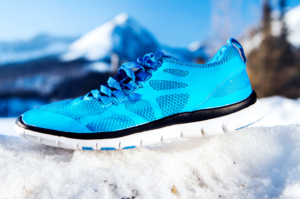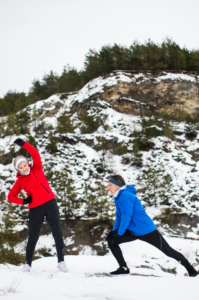Running in cold weather can be a fantastic outlet for your winter stress and can pick you up if you get the winter blues. If you live in a cooler climate and don’t want to lose your endurance over winter or are starting a training program in the early months of the year, cold weather training can be key to your success. Use these five tips for a better cold-weather running experience and make running outdoors safer and more enjoyable this season.
1. DRESS FOR SUCCESS
We know that running raises our core temperature, but it’s not easy to figure out the perfect level of dress for running outdoors. Start with checking the weather. Your pre-run weather check is critical for understanding the wind and weather. A good rule of thumb is to add 15 degrees to the outdoor temperature for the “feels-like” temperature during running. Of course, some of us run hotter than others, but it gives you a nice gauge of how warm you will get on your run.
Second, dress in layers. Obviously, you will start out colder and warm up as you run, but having the perfect type of gear to peel off is what makes layering a great strategy. Avoid pullovers and bulky gear. Instead, wear items that are easy to remove. Your favorite fleece-lined quarter zip is perfect for an outdoor hike but peeling it off during a run is like trying to get out of a straight jacket! A breathable running jacket with a full zipper is perfect for cold-weather runs. It’s easy to take off and wrap around your waist when the time is right and the pockets are perfect for stashing away your gloves, headband, or hat in colder weather. Full-zip running jackets are also perfect for the inevitable freeze during your cool-down. Just reverse the process to stay comfortable as your core temperature begins to drop.
2. CHECK YOUR TREAD
 Cold-weather running is always a little dicey, but there are some strategies that can reduce your chances of an injury. One key strategy is to only wear running shoes with fresh tread. Snow-packed trails can get slippery! Your running shoes are just like snow tires. The shallower the grooves, the harder it will be to maintain traction.
Cold-weather running is always a little dicey, but there are some strategies that can reduce your chances of an injury. One key strategy is to only wear running shoes with fresh tread. Snow-packed trails can get slippery! Your running shoes are just like snow tires. The shallower the grooves, the harder it will be to maintain traction.
If cold-weather running is going to be a regular occurrence for you, consider upgrading to a trail shoe that is similar to your preferred training shoe. As always, our team of running injury specialists will tell you to avoid the big-box stores and get great advice while shopping locally. We recommend working with a local running-specific store, like TerraLoco in Rochester, for the best recommendations for your feet and your needs. Check out this great Runner’s World blog on the best winter running shoes.
3. DYNAMIC WARM-UP IS A MUST
 One of the simplest things you can do as a runner to prevent injury during cold-weather running is to effectively warm up. Static stretches (think stretch and hold for 30 seconds) can actually increase your risk for injury when performed immediately before running. Static stretches also do not effectively increase blood flow to a muscle for injury prevention.
One of the simplest things you can do as a runner to prevent injury during cold-weather running is to effectively warm up. Static stretches (think stretch and hold for 30 seconds) can actually increase your risk for injury when performed immediately before running. Static stretches also do not effectively increase blood flow to a muscle for injury prevention.
Instead, use dynamic or “moving” stretches to warm-up before your run. In cold weather, your dynamic warm-up should last at least 5-10 minutes. Yes, we know that’s a lot to ask of runners before starting your Garmin! This can include leg swings, walking toe-touches, walking glute stretches, and many other options to warm up key muscles before your run. Check out our blog on how to run more effectively and efficiently with a dynamic warm-up.
4. SHORT STRIDES
Running cadence or stride length is a hot topic among distance runners. In cold-weather running, however, it’s critical for safety. When your running surface is slippery, shorter strides can help. Shorter strides (faster turnover) helps you conserve energy and react faster if you slip. As a side bonus, it also helps reduce leg stiffness after running! Google fast cadence running songs to help keep your turnover high during cold-weather runs.
5. STAY HYDRATED
Just because it’s cold out, doesn’t mean we can throw our standard running hydration out the window. While your sweat rate will be higher in hotter weather, you still need good hydration for effective running. Hydration throughout the day is always better than right before a run. Avoiding pre-run chugging also helps avoid the desperate need to “go” during a run…..circling back to the “straight jacket” issue again!
Garrison completed his Doctorate in Physical Therapy at the University of Wisconsin La-Crosse. Prior to his graduate studies, he earned his B.S. in Exercise Sports Science from UWL where he played for the club soccer team. He is an RRCA certified running coach. In his free time, he enjoys staying active with running, hiking, weight training, and competing in all sports. He has a passion for taking on new challenges such as learning to play the guitar and running marathons.




